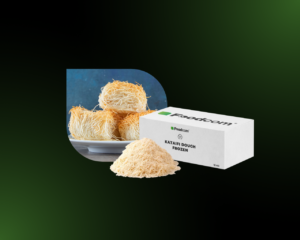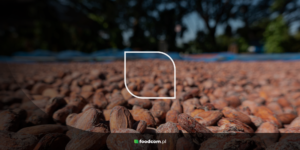- Kataifi dough is a stringy dough of oriental origin, common in Greece, Turkey, and the Middle East.
- It comes in raw and roasted versions, making it versatile in use, from desserts to savory dishes.
- The product is perceived as premium, with great marketing and culinary potential.
Kataifi is a thinly sliced pastry with a unique texture and a wide range of culinary uses, particularly popular in Middle Eastern, Greek and Turkish cuisines. This crispy and tender pastry is a traditional ingredient in many desserts, but also in dry dishes. It is also increasingly becoming a sought-after product in the food industry. Let’s take a look at what Kataifi cake is and why it is worth getting interested in it.
What is Kataifi cake?
Kataifi dough is a type of very thin, stringy dough made usually from wheat flour and water, and often sugar, salt and fat. The composition of the dough resembles filo pastry, but Kataifi is in the form of thin strands. It is still reminiscent of a thin version of capellini pasta (known as strands or angel hair), but unlike pasta, it is raw dough and not dried.
Kataifi dough is flexible and mouldable, making it ideal for wrapping fillings – both sweet and salty. It is available on the market in two versions: as raw kataifi dough for further cooking and crispy, roasted or baked kataifi – ready to be used as a topping, decoration or snack ingredient.
Where does kataifi cake come from?
Kataifi cake originated in the Middle East and Mediterranean regions, where it has been used in traditional cuisine for centuries. It has gained its greatest popularity in Greece and Turkey, and its presence in the recipes of desserts such as baklava and kunafa makes it a recognisable symbol of the local culinary culture. In recent years, kataifi has also been gaining popularity in Western Europe and Poland.
What does a kataifi cake taste like?
The taste of kataifi is quite neutral – slightly cereal and mildly salty, so it absorbs the flavours of the additives perfectly. In its raw version, it is suitable for baking and frying, while roasted kataifi has a slightly nutty aftertaste and a crunchy texture that adds texture to dishes and desserts. The dough can be used as a crunchy element in desserts such as Dubai chocolate and pistachio creams.
How many calories does kataifi have?
The calorie value of the cake depends on how it is processed. On average, raw kataifi cake provides around 280-320 kcal per 100 grams. The roasted version, on the other hand, depending on the fat used (e.g. clarified butter, sunflower oil), can contain as much as 450-500 kcal per 100 grams. Kaifi is therefore suitable for both dietary and calorie-rich items – depending on the processing and additives used.
In which dishes and products is Kataifi dough used?
Kataifi dough is truly versatile – its texture and neutral flavour make it suitable for both sweet and savoury dishes. Kataifi goes particularly well with syrups, honey, nuts and creams.
Desserts and confectionery
Kataifi has undoubtedly gained its greatest popularity through its presence in desserts. In the Middle East, it is often served as a crunchy dessert baked with nuts or pistachios and topped with syrup or rose water. Similar desserts are Greek baklava and Middle Eastern kunafa (Kanafeh), where the dough is filled with cheese and poured all over with sugar syrup.
Roasted kataifi is also ideal as a topping for cakes, such as cheesecake or ice cream. It is also an ingredient in products such as Dubai chocolate, where the filling is combined with pistachio paste, giving the familiar snack a crunchy feel.
Dry dishes
Kataifi dough is sometimes used in artisan cuisine. Roasted, the dough can be used as croutons or nuts in salads. It is also often used to create rolls with meat or vegetable stuffing, and seafood such as prawns can also be wrapped in it.
Food industry
Kataifi dough also makes it possible to create ready-made, often frozen dishes or products. It is also sometimes used to make chilled mousses and desserts. Kataifi without added butter is also ideal for vegetable dishes – in many recipes it can replace puff pastry or filo pastry.
How do you store Kataifi dough?
Raw kataifi cake needs to be refrigerated and is best stored between 0 and 4°C, in a container to protect it from drying out. In frozen form, it can be stored for up to several months. Roasted kataifi is definitely easier in logistics – it is stored in a dry and cool place, away from light and moisture. It has a longer shelf life, making it an ideal product for caterers, dessert makers and bakeries.
Where to buy Kataifi cake in Poland?
The availability of kataifi in Poland is increasing with the demand from the food industry. One distributor offering kataifi in bulk quantities is Foodcom.co.uk, a company specialising in supplying food raw materials to the industry.
Why introduce kataifi into your B2B offering? First of all, kataifi is not yet widely used in Poland, which provides an opportunity to offer unique products with kataifi in the composition. The product is perceived as premium, which allows for higher final product prices. In addition, due to its multifunctionality, it is suitable for both sweet and salty products, as well as hot to cold dishes.
Kataifi dough is a product with huge potential in the food industry. Whether you are interested in raw kataifi for baking oriental delicacies or roasted kataifi as an innovative sprinkle for desserts or an ingredient in Dubai chocolate, this dough will undoubtedly enrich your offer and increase your competitiveness in the market.











